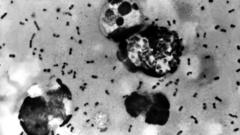Could a Plague Outbreak in Arizona Be a Growing Concern?

Understanding Pneumonic Plague: Risks, Symptoms, and Prevention
The recent death of a resident in Arizona due to pneumonic plague has brought this disease back into the public consciousness. While it may conjure images of historical pandemics, pneumonic plague is a serious albeit rare infection that can be treated with prompt medical attention. In this article, we will explore the nature of pneumonic plague, its symptoms, prevention methods, and the overall risk it poses to the public today.
What is Pneumonic Plague?
Pneumonic plague is a severe lung infection caused by the bacterium Yersinia pestis. It is one of the three forms of plague, the others being bubonic and septicemic plague. Pneumonic plague is particularly dangerous because it can spread from person to person through respiratory droplets, making it more contagious than its bubonic counterpart, which is primarily transmitted through flea bites.
Historical Context: The Black Death
Plague has a notorious history, most famously known as the "Black Death" during the 14th century, which decimated nearly half of Europe's population. While this disease is now rare in modern times, it remains a public health concern in certain areas, particularly in the western United States, where a small number of cases are reported each year.
Current Statistics and Public Health Risk
According to the Centers for Disease Control and Prevention (CDC), an average of seven human plague cases is reported annually in the United States, with most cases occurring in rural areas of the West. The recent fatality in Coconino County marks the first recorded death from pneumonic plague in that region since 2007, highlighting the need for awareness and education about this disease. However, health officials assert that the risk of widespread exposure remains low, particularly as the disease is treatable with antibiotics when caught early.
Forms of Plague and Their Symptoms
Understanding the various forms of plague is crucial for recognizing symptoms and seeking timely medical intervention. Here are the three primary forms of plague:
- Bubonic Plague: The most common form, caused by flea bites. Symptoms include fever, chills, headache, weakness, and swollen lymph nodes, often referred to as "buboes." Symptoms typically appear within two to eight days after exposure.
- Pneumonic Plague: This form affects the lungs and can develop from untreated bubonic or septicemic plague. Symptoms include cough, chest pain, difficulty breathing, and bloody sputum. Pneumonic plague can progress rapidly, often leading to severe respiratory distress.
- Septicemic Plague: This is the most severe form, occurring when the bacteria enter the bloodstream. Symptoms can include high fever, chills, rapid heart rate, and abdominal pain.
How is Pneumonic Plague Transmitted?
Pneumonic plague can be transmitted in several ways, primarily through:
- Infected Flea Bites: As with bubonic plague, fleas that have bitten infected animals can transmit the bacteria to humans.
- Contact with Infected Animals: Handling or being in close proximity to infected animals, particularly rodents, can also pose a risk.
- Person-to-Person Spread: Unlike other forms of plague, pneumonic plague can be transmitted between people through respiratory droplets, especially in crowded living conditions or close contact with an infected individual.
Diagnosis and Treatment
Prompt diagnosis and treatment are critical for anyone suspected of having pneumonic plague. Medical professionals typically perform the following steps:
- Medical History: A thorough medical history will help clinicians determine potential exposure risks.
- Physical Examination: A physical examination focusing on respiratory symptoms and swollen lymph nodes is essential.
- Laboratory Tests: Blood tests, sputum samples, or lymph node aspirates may be analyzed to detect the presence of Yersinia pestis.
If diagnosed early, pneumonic plague can be effectively treated with antibiotics, such as streptomycin, doxycycline, or ciprofloxacin. It is crucial for anyone experiencing symptoms, particularly after potential exposure, to seek medical attention immediately.
Preventative Measures
Preventing pneumonic plague involves a combination of personal and community health strategies. Here are several effective measures:
- Use Insect Repellent: Applying a DEET-based insect repellent can help protect against flea bites, which are a common transmission route for plague.
- Avoid Contact with Wild Animals: Stay away from dead animals and avoid handling them, especially in areas where plague is known to occur.
- Practice Good Hygiene: Wash hands frequently and maintain cleanliness to reduce the risk of infection.
- Stay Informed: Keep up with local health advisories and updates regarding plague cases in your area.
- Limit Close Contact with Infected Individuals: If someone is suspected of having pneumonic plague, avoid close contact until they have been diagnosed and treated.
Conclusion
Pneumonic plague, while rare, continues to be a serious public health concern in specific regions. The recent report of a death in Arizona serves as a reminder of the importance of awareness, prevention, and rapid treatment. By understanding the symptoms and transmission methods, individuals can take proactive steps to protect themselves and their communities. As we navigate the complexities of infectious diseases, it's vital to foster a culture of vigilance and education surrounding health risks.
FAQs about Pneumonic Plague
What causes pneumonic plague?
Pneumonic plague is caused by the bacterium Yersinia pestis, which can affect the lungs and is often a progression of untreated bubonic or septicemic plague.
Is pneumonic plague contagious?
Yes, pneumonic plague can spread from person to person through respiratory droplets, making it more contagious than other forms of plague.
How can I protect myself from pneumonic plague?
Protect yourself by using insect repellent, avoiding contact with potentially infected animals, practicing good hygiene, and staying informed about local health advisories.
What are the symptoms of pneumonic plague?
Symptoms include severe respiratory issues such as cough, chest pain, difficulty breathing, and bloody sputum, along with fever and chills.
How is pneumonic plague treated?
Pneumonic plague is treated with antibiotics, which are most effective when administered early in the course of the disease.
As we learn from the past, it is essential to remain vigilant about health threats like pneumonic plague. How aware are you of the risks in your area? #PneumonicPlague #PublicHealth #InfectiousDiseases
Published: 2025-07-12 15:26:14 | Category: world



